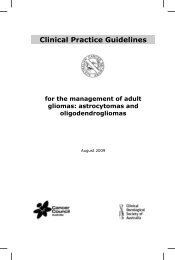Clinical Practice Guidelines for the management of locally advanced ...
Clinical Practice Guidelines for the management of locally advanced ...
Clinical Practice Guidelines for the management of locally advanced ...
You also want an ePaper? Increase the reach of your titles
YUMPU automatically turns print PDFs into web optimized ePapers that Google loves.
half <strong>of</strong> patients experienced pain relief but overall survival was poor, with median survival <strong>of</strong> four<br />
months. Although no significant differences in <strong>the</strong> fractionation schedules were seen, clinically<br />
significant differences could not be excluded. One-year survival was 18% <strong>for</strong> <strong>the</strong> longer fractionation<br />
versus 10% with <strong>the</strong> shorter approach. Five (versus none) infield recurrences were seen in <strong>the</strong> shorter<br />
fractionation group.<br />
Evidence summary Level References<br />
There are no randomised trials comparing radio<strong>the</strong>rapy with ei<strong>the</strong>r<br />
surgery or dexamethasone alone <strong>for</strong> spinal cord compression. There<br />
is one randomised trial comparing two different fractionation<br />
schedules <strong>for</strong> unfavourable risk malignant spinal cord compression.<br />
It demonstrated no significant differences between <strong>the</strong> schedules,<br />
though clinically important differences cannot be excluded<br />
Recommendation<br />
II 82<br />
For patients with malignant spinal cord compression <strong>the</strong> use <strong>of</strong> radiation is recommended.<br />
The optimal fractionation schedule <strong>of</strong> radio<strong>the</strong>rapy is unknown.<br />
Grade D<br />
Patients being treated with radiation <strong>for</strong> spinal cord compression should be given<br />
dexamethasone at time <strong>of</strong> diagnosis.<br />
Grade B<br />
The role <strong>for</strong> surgery has long been controversial in malignant spinal cord compression from metastatic<br />
prostate cancer. It is acknowledged that <strong>the</strong> outcomes with radio<strong>the</strong>rapy alone are suboptimal,<br />
especially if patients are non-ambulatory or paraplegic at presentation. However, clinicians had<br />
concerns subjecting patients who are <strong>of</strong>ten unwell with a poor median survival to <strong>the</strong> rigors <strong>of</strong> surgery<br />
<strong>for</strong> a non-quantifiable degree <strong>of</strong> benefit. Also, it was not known whe<strong>the</strong>r surgery should consist <strong>of</strong> a<br />
decompression laminectomy alone (to relieve pressure on <strong>the</strong> spinal cord) or <strong>the</strong> more aggressive<br />
circumferential decompression laminectomy where <strong>the</strong> entire affected vertebrae is removed.<br />
Decompressive laminectomy should be considered when radio<strong>the</strong>rapy cannot be given due to<br />
previous treatment or progression during or shortly after radio<strong>the</strong>rapy.<br />
There are only two randomised trials comparing surgery with radio<strong>the</strong>rapy versus radio<strong>the</strong>rapy<br />
alone. 83, 84 The Patchell study <strong>of</strong> 101 patients (16% with prostate cancer) compared radio<strong>the</strong>rapy alone<br />
with direct circumferential decompression (with spinal stabilisation if spinal instability present)<br />
followed by radio<strong>the</strong>rapy.<br />
The Patchell study demonstrated a clinically significant improvement with <strong>the</strong> addition <strong>of</strong> aggressive<br />
surgery to radiation only and was stopped early as it met pre-set termination criteria. For ambulatory<br />
patients at presentation, 94% versus 74% were walking post-treatment in <strong>the</strong> surgery and radio<strong>the</strong>rapy<br />
arms respectively. For non-ambulatory patients, <strong>the</strong> rates were 62% versus 19%. There was a median<br />
survival improvement <strong>of</strong> 126 versus 100 days (p=0.03) and a significant improvement in pain levels<br />
as judged by median mean daily morphine doses (p=0.002) with surgery.<br />
63<br />
Overt metastatic disease and/or loco-regional progressive disease



